Ireland & Britain
England & Scotland
Travel Stories
Interests & Hobbies
Outdoors & Activities
Advice for Visitors
About My Ireland Tour
News & What's On

Mountsandel is the oldest known settlement of man in Ireland, dating back to between 7900 and 7600 BC. Ulster was invaded by Normans I 1171 and fell under their rule for the following 150 years. Following the plantation of thousands of English and Scottish people into Northern Ireland by King James l, in 1610, plantation houses and castles began to appear across the landscape. The best example of a castle from this period, that still stands today, is Dunluce Castle in County Antrim. On this page you can find the castles and ancient settlements that tell the story of Northern Ireland's past.
Carrickfergus Castle is a Norman castle located on the northern shores of Belfast Lough. The castle was first built by in 1177 by John de Courcy after he conquered eastern Ulster. In 1210 King John of England took control of the castle and has remained under British control ever since. Carrickfergus Castle was used as a garrison for British troops during the First World War and as an air raid shelter in World War II.
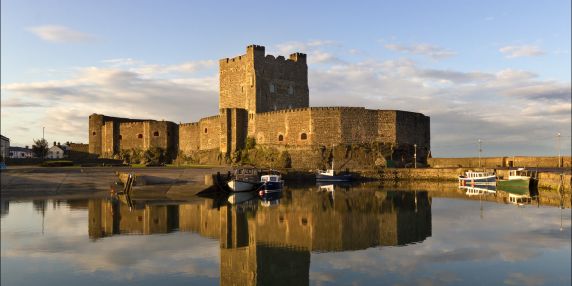
If you are visiting Carrickfergus Castle it is worth noting that disabled access is very limited for wheelchair users.
Today, Dunluce Castle lies in ruins. Once the seat of Clan McDonnell, found between the towns of Portballintrae and Portrush in County Antrim, the castle is perched on a cliff face with steep drops to the sea on either side. Originally built by Richard Óg de Burgh in the 13th century and then the McQuillan family in 1513 until it was given over to the MacDonnell family after their victory in two battles in the mid to late 16th century.
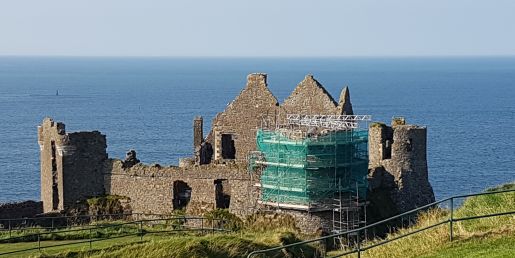
The castle was passed down through different families in the British royal family up until the Battle of the Boyne in 1690, after which time it fell into disrepair and was torn apart for materials to aid the construction of nearby buildings. In the 18th century the north wall of the building collapsed into the sea, today the other three walls still stand.
Following John de Courcy's invasion of Ulster in the 13th century, he ordered the construction of Dundrum Castle. The castle is perfectly located to serve as a lookout across Dundrum Bay, to the south, the low lying laid running towards Slieve Croob, to the east, and the plains of Lecale, to the east. The castle, like others in Northern Ireland, was taken over by King John of England in 1210 and then passed down through the British royal family. Today the castle lies in ruins and is a very popular attraction for school tours and tourists visiting the area.
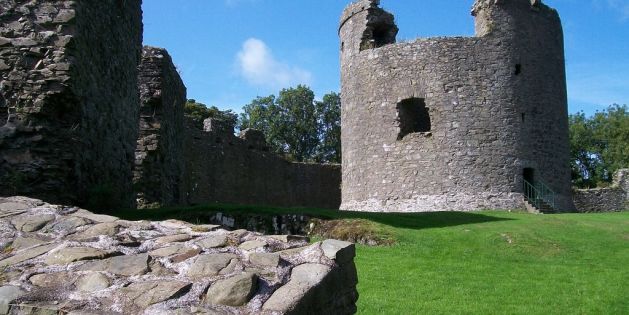
Belfast Castle, an iconic landmark perched on the slopes of Cave Hill, offers a fascinating glimpse into the rich history and cultural heritage of Northern Ireland. Its origins trace back to the 12th century, when the Normans first constructed a fortification in the area. However, the castle we see today has undergone several transformations, reflecting the changing times and fortunes of its owners. In 1611, Sir Arthur Chichester, the Baron of Belfast, embarked on a significant rebuilding project.
This new iteration of Belfast Castle was constructed using stone and timber, creating a robust and imposing structure. However, this version of the castle came to a tragic end when it was destroyed by fire in 1708. The Chichester family decided not to rebuild on the same site, leading to the creation of the current Belfast Castle on Cave Hill.
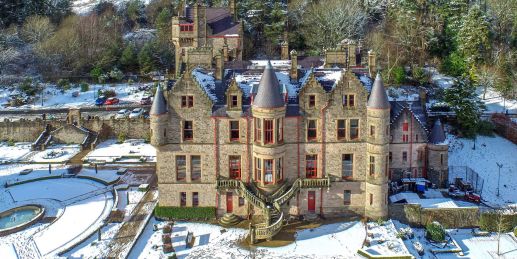
The present Belfast Castle, completed in 1870, owes its existence to Lord Ashley, the 8th Earl of Shaftesbury, a relative of Sir Arthur Chichester. The building of the castle, which cost £11,000, was a substantial investment at the time. The design, undertaken by the architect John Lanyon, features a Scottish baronial style, particularly in its turrets and gables. Lord Ashley inherited Belfast Castle in 1884, further strengthening the Shaftesbury family's connection to the site.
Today, Belfast Castle is used as a venue for contemporary events. Its meticulously landscaped gardens, offering unmatched views of the city and the surrounding countryside, make it a popular spot for afternoon tea, weddings, and other public engagements. The castle's interior is carefully maintained and restored, giving a regal backdrop for celebrations, conferences, and cultural events.
Keep an eye out for the resident white cat of Belfast Castle. The cat is said to bring good fortune to those who visit, as long as the tradition of keeping a white cat as a castle resident is upheld.
You'll find access to Belfast Castle from Belfast City centre, with a number of buses running to the Cave Hill area. The bus ride takes about 20 minutes in total. The tour is self guided and you can choose your own route around the castle. Restrictions are often in place in the interior, and many rooms may be closed off or out of bounds.
Belfast Castle is open from 9am to 6pm daily.
Belfast Castle is free to enter.
Giant's Ring is a prehistoric circular enclosure located 5 km outside Belfast City. It is believed to have been built around 2700BC, in the Neolithic period, meaning that it older than the Egyptian pyramids. It is thought to have been originally used as a passage tomb. The outer, raised ridge has a diameter of 590 ft housing a Megalithic tomb in its centre. During the 18th century horse racing events were held at the site.
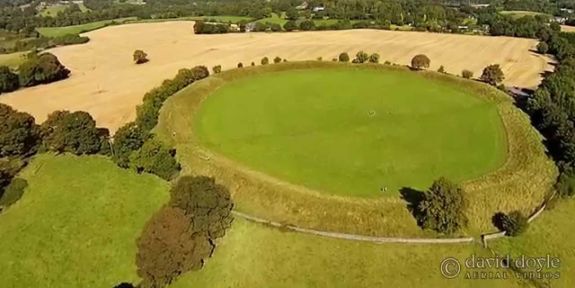
Beaghmore is a collection of different stone circles, cairns (man-made piles of stones) and Bronze Age megalithic features. Investigations of the area indicate that the site was used as early as the Neolithic era. it is thought that the area was used mainly as a focal point for religious gatherings and social events. A number of the cairns have been found to contain cremated human remains held within small crypts. Archaeologists also believe, due to the stones circles alignment with the rising sun at the solstice, that they were placed where they are in observation of particular solar events.
